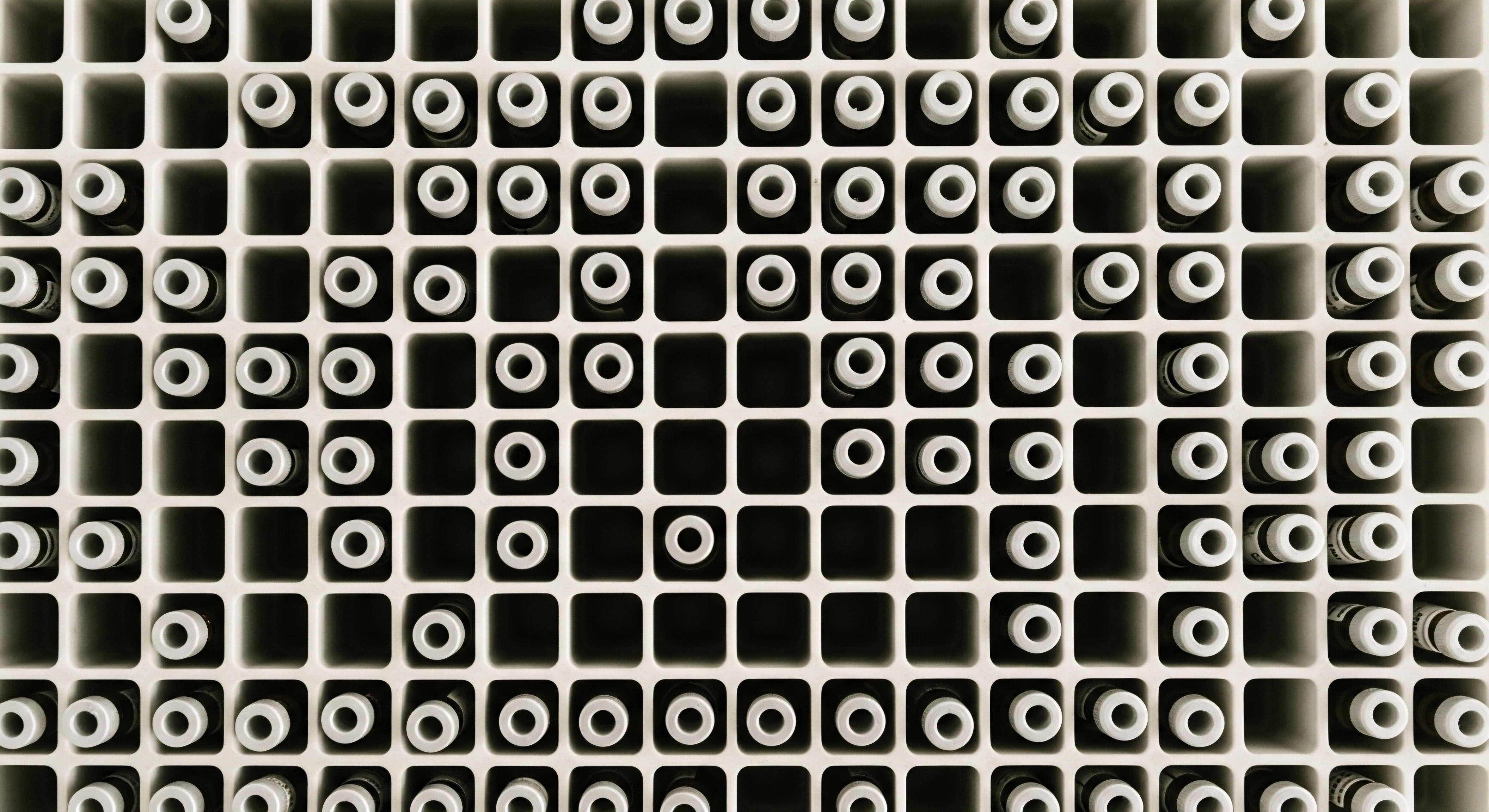

Fundamentals
The question of whether lifestyle changes alone can reverse a diagnosis of hypogonadism after the age of 50 is one that touches upon a deep desire for agency over one’s own biological vitality. You have likely arrived here because of a shift in your well-being, a collection of symptoms that feel like a departure from the man you have always known yourself to be.
Fatigue, a decline in physical strength, a muted sense of vitality, or changes in mood and cognitive focus are all valid experiences. These are the very real, subjective signals that your internal biochemistry is changing. The diagnosis of hypogonadism provides a clinical name for this experience, identifying a measurable decline in testosterone production.
This moment is a critical juncture. It is an invitation to understand the intricate communication network that governs your endocrine system and to appreciate that you are a dynamic, adaptable biological system.
At its core, your body is a system of systems, and hormonal health is a reflection of the seamless integration of these systems. The production of testosterone is not an isolated event occurring in the testes. It is the final step in a sophisticated cascade of signals that begins in the brain, specifically within the hypothalamus and pituitary gland.
This is known as the Hypothalamic-Pituitary-Gonadal (HPG) axis. Think of it as a command-and-control structure. The hypothalamus sends a signal, Gonadotropin-Releasing Hormone (GnRH), to the pituitary. The pituitary, in turn, releases Luteinizing Hormone (LH) and Follicle-Stimulating Hormone (FSH) into the bloodstream.
LH is the direct messenger that instructs the Leydig cells in the testes to produce testosterone. When this axis functions optimally, testosterone levels are maintained within a healthy range, supporting everything from muscle mass and bone density to cognitive function and libido. A diagnosis of hypogonadism signifies a disruption somewhere along this chain of command.
The distinction between primary and secondary hypogonadism is an important one. Primary hypogonadism indicates an issue at the level of the testes themselves. Perhaps due to a past injury, illness, or a genetic condition, the testes are unable to produce sufficient testosterone despite receiving the correct signals from the brain.
Secondary hypogonadism, which is more common in the context of aging and lifestyle factors, points to a problem with the signals originating from the hypothalamus or pituitary. In this scenario, the testes are perfectly capable of producing testosterone, but the instructions to do so are faint or inconsistent.
This is where the conversation about lifestyle intervention becomes most relevant. The signaling centers in the brain are exquisitely sensitive to the broader metabolic environment of the body. Chronic inflammation, insulin resistance, high levels of the stress hormone cortisol, and poor sleep quality all act as disruptive static, interfering with the clear transmission of hormonal messages.
Lifestyle modifications are a foundational component of managing low testosterone, as they directly influence the metabolic and inflammatory factors that can suppress the body’s natural hormone production.
Therefore, when we discuss lifestyle changes, we are talking about a strategy to restore clarity to this internal communication system. We are aiming to reduce the metabolic noise that is dampening the HPG axis. This is a profound shift in perspective. It moves the focus from a single hormone to the health of the entire system.
By addressing the root causes of the signaling disruption, we create the conditions for the body to recalibrate itself. This journey is about more than just raising a number on a lab report; it is about restoring the integrity of your body’s innate regulatory processes, leading to a more resilient and functional state of being.
The symptoms you are experiencing are real, and they are directly linked to these biological mechanisms. Understanding this connection is the first step toward reclaiming your vitality.


Intermediate
To appreciate the potential for lifestyle interventions to reverse functional hypogonadism, we must examine the specific mechanisms through which they operate. These are not passive, hopeful gestures; they are targeted inputs that directly influence the biochemical pathways governing testosterone synthesis and signaling.
The conversation moves from the “what” to the “how,” providing a clear, evidence-based rationale for each strategic modification. For men over 50 diagnosed with functional hypogonadism, where the signaling from the brain is the primary issue, these interventions can be powerfully restorative.

Recalibrating the Metabolic Engine
One of the most potent levers we can pull is the management of body composition and insulin sensitivity. Excess adipose tissue, particularly visceral fat around the organs, functions as an active endocrine organ. It produces inflammatory cytokines and, critically, high levels of an enzyme called aromatase.
Aromatase directly converts testosterone into estradiol, a form of estrogen. This process simultaneously lowers available testosterone and increases estrogen, further disrupting the delicate hormonal balance that supports masculine health. A lifestyle strategy focused on reducing body fat is, in essence, a strategy to down-regulate this testosterone-depleting enzymatic activity.
Achieving and maintaining a healthy weight through a combination of nutritional adjustments and regular physical activity can have a significant impact. Studies have demonstrated that weight loss in overweight and obese men can lead to substantial increases in total and free testosterone levels. This occurs for several reasons:
- Reduced Aromatase Activity ∞ Less fat mass means less aromatase enzyme available to convert testosterone to estrogen.
- Improved Insulin Sensitivity ∞ High insulin levels, characteristic of insulin resistance, are known to suppress LH release from the pituitary gland. By improving insulin sensitivity through diet and exercise, you are effectively removing a brake on the HPG axis, allowing for more robust signaling to the testes.
- Lowered Inflammation ∞ Adipose tissue is a source of chronic, low-grade inflammation. This inflammatory state can suppress hypothalamic function, further dampening the initial GnRH signal that starts the entire testosterone production cascade.

The Anabolic Power of Movement
Exercise is a powerful modulator of the endocrine system, with effects that extend far beyond simple calorie expenditure. The type, intensity, and consistency of physical activity all play a role in optimizing the hormonal environment.
Resistance training, in particular, has been shown to acutely increase testosterone levels. This is a direct response to the metabolic demand and microscopic muscle damage that occurs during lifting. The body perceives this as a signal that it needs to repair and build tissue, a process for which testosterone is a key anabolic agent.
A combination of resistance training and aerobic exercise appears to be the most effective approach. Aerobic exercise contributes to fat loss and improves cardiovascular health, which is critical for efficient hormone transport throughout the body, while resistance training provides the direct stimulus for testosterone production and improves insulin sensitivity in the muscle tissue itself.
A disciplined approach to diet and exercise directly counteracts the primary mechanisms of functional hypogonadism by reducing aromatase activity, improving insulin sensitivity, and lowering systemic inflammation.

The Critical Role of Rest and Recovery
The importance of sleep in hormonal regulation cannot be overstated. A significant portion of daily testosterone release occurs during sleep, specifically during the deep, restorative stages. Chronic sleep deprivation, a common issue in modern life, directly disrupts this process. Studies have shown a clear correlation between sleep duration and quality and morning testosterone levels.
High levels of the stress hormone cortisol, which are often a consequence of poor sleep and chronic stress, are also directly antagonistic to testosterone production. Cortisol and testosterone have a see-saw relationship; when one is high, the other tends to be low. Therefore, implementing strategies to improve sleep hygiene and manage stress are not ancillary wellness practices; they are direct interventions to support the HPG axis and optimize testosterone production.
The following table outlines the key lifestyle interventions and their direct mechanistic impact on the male endocrine system:
| Intervention | Primary Biological Mechanism | Effect on HPG Axis |
|---|---|---|
| Weight Management (Fat Loss) | Reduces aromatase enzyme activity and systemic inflammation. | Decreases conversion of testosterone to estrogen; reduces suppression of hypothalamic GnRH release. |
| Resistance Training | Stimulates acute testosterone release for muscle repair and growth. | Provides a direct anabolic signal, potentially increasing LH sensitivity. |
| Aerobic Exercise | Improves insulin sensitivity and cardiovascular health. | Reduces insulin-related suppression of pituitary LH release. |
| Optimized Sleep | Facilitates nocturnal testosterone release and lowers cortisol. | Supports the natural diurnal rhythm of testosterone production. |
| Stress Management | Lowers circulating cortisol levels. | Reduces the antagonistic effect of cortisol on testosterone production. |
While lifestyle changes can produce significant improvements, it is also important to recognize their limitations. In cases of primary hypogonadism, where the testes themselves are damaged, lifestyle changes alone are unlikely to restore normal testosterone levels. Similarly, for some men with severe secondary hypogonadism, these interventions may not be sufficient to bring testosterone into the optimal range and alleviate all symptoms.
In these cases, a comprehensive approach that combines lifestyle optimization with medical therapies like Testosterone Replacement Therapy (TRT) or other protocols designed to stimulate the HPG axis, such as those using Gonadorelin or Clomiphene, may be the most effective path forward.


Academic
A sophisticated analysis of functional hypogonadism in aging men requires a departure from a simple model of hormonal decline. Instead, we must view it as a state of “non-gonadal illness” (NGI), a concept suggesting that the suppression of the Hypothalamic-Pituitary-Gonadal (HPG) axis is a physiological adaptation to underlying systemic pathologies, most notably metabolic syndrome and chronic inflammation.
The question of reversal through lifestyle hinges on whether these interventions can correct the root pathophysiology to a degree sufficient to restore normative HPG axis tone and function. The evidence points to a significant, though not universally complete, potential for reversal, contingent on the degree of underlying metabolic derangement and the patient’s capacity for sustained lifestyle modification.

The Pathophysiology of Functional Hypogonadism
Functional hypogonadism in men over 50 is often characterized by borderline-low serum testosterone with low-normal Luteinizing Hormone (LH) levels. This biochemical signature points away from primary testicular failure and toward a central suppression. The primary drivers of this suppression are well-documented:
- Adipose-Derived Inflammation and Aromatization ∞ Visceral adipose tissue (VAT) is a metabolically active organ that secretes a host of pro-inflammatory cytokines, such as TNF-α and IL-6. These cytokines have been shown to exert a direct suppressive effect on GnRH neurons in the hypothalamus. Concurrently, VAT is the primary site of peripheral aromatization of testosterone to estradiol. The resulting increase in estradiol exerts negative feedback on both the pituitary and the hypothalamus, further dampening LH and GnRH secretion.
- Insulin Resistance and Hyperinsulinemia ∞ Insulin resistance, a hallmark of metabolic syndrome, leads to compensatory hyperinsulinemia. Elevated insulin levels are directly implicated in the suppression of LH pulse frequency and amplitude from the pituitary gland. This creates a vicious cycle, as low testosterone itself can exacerbate insulin resistance, perpetuating the state of central suppression.
- Leptin and Ghrelin Dysregulation ∞ Obesity is associated with leptin resistance. While leptin is typically a permissive signal for GnRH release, a state of resistance can disrupt this signaling. The complex interplay of metabolic hormones creates a systemic environment that is non-conducive to robust reproductive axis function.
From this perspective, the low testosterone is a symptom of a larger metabolic disease state. The body, under conditions of perceived metabolic stress and inflammation, may be adaptively down-regulating the energetically expensive reproductive axis. Therefore, therapeutic interventions must be aimed at correcting the metabolic dysfunction itself.

Can Lifestyle Interventions Reverse the Pathology
The efficacy of lifestyle interventions lies in their ability to directly target these pathophysiological mechanisms. A structured program of diet-induced weight loss and exercise can fundamentally alter the metabolic landscape.
Weight loss, particularly the reduction of visceral fat, is the most critical intervention. Studies have quantified this effect, showing that significant weight loss can increase total testosterone by a substantial margin. This is a direct consequence of reduced aromatase activity and a decrease in the systemic inflammatory load. As VAT shrinks, the production of TNF-α and IL-6 diminishes, lifting the suppressive “brake” on the hypothalamus. This allows for a potential restoration of normal GnRH pulsatility.
Exercise contributes through multiple synergistic pathways. Resistance training creates a demand for anabolic processes, which can improve the sensitivity of the HPG axis. Aerobic exercise is a powerful tool for improving insulin sensitivity, thereby reducing the suppressive effect of hyperinsulinemia on the pituitary. The combination of these modalities addresses both the inflammatory and the insulin-signaling components of functional hypogonadism.
The following table provides a detailed overview of specific biomarkers and their response to targeted lifestyle interventions, illustrating the mechanistic pathway to potential reversal.
| Biomarker | Impact of Metabolic Dysfunction | Effect of Lifestyle Intervention |
|---|---|---|
| C-Reactive Protein (CRP) | Elevated due to adipose-derived inflammation. | Decreases with fat loss, indicating reduced inflammatory load on the hypothalamus. |
| Aromatase Activity | Increased in visceral adipose tissue. | Decreases with fat loss, reducing testosterone to estradiol conversion. |
| Fasting Insulin / HOMA-IR | Elevated due to insulin resistance. | Decreases with exercise and improved diet, reducing pituitary suppression. |
| Luteinizing Hormone (LH) Pulsatility | Suppressed by inflammation and hyperinsulinemia. | May increase in frequency and amplitude as suppressive signals are removed. |
| Sex Hormone-Binding Globulin (SHBG) | Often decreased in states of insulin resistance. | Tends to increase with weight loss and improved insulin sensitivity, affecting total testosterone levels. |

Limitations and the Role of Hormonal Optimization
While the theoretical basis for reversal is strong, the practical application has limitations. The degree of reversal is proportional to the degree of lifestyle change and the individual’s physiological responsiveness. For some men, even significant weight loss and exercise may only produce a modest increase in testosterone levels, which may not be sufficient to resolve all symptoms.
The duration and severity of the metabolic dysfunction may have induced a more permanent recalibration of the HPG axis setpoint. Furthermore, adherence to the necessary lifestyle changes is a significant challenge.
In such cases, a purely lifestyle-driven approach may be insufficient. This is where a carefully managed clinical protocol becomes a logical next step. For men who remain symptomatic despite good-faith efforts at lifestyle modification, Testosterone Replacement Therapy (TRT) can be considered.
The goal of TRT in this context is to restore physiological levels of testosterone to alleviate symptoms and to help break the vicious cycle of low testosterone and poor metabolic health. Higher testosterone levels can make it easier to lose fat and build muscle, which in turn supports the underlying goals of the lifestyle intervention.
For men concerned about preserving testicular function and fertility, protocols involving agents like Gonadorelin or Clomiphene can be used to directly stimulate the HPG axis, encouraging the body’s own production of testosterone. These interventions should be viewed as tools to work in concert with, not in place of, a foundational commitment to lifestyle optimization.

References
- Dandona, P. & Rosenberg, M. T. (2010). A practical guide to male hypogonadism in the primary care setting. The International Journal of Clinical Practice, 64 (6), 682 ∞ 696.
- Grossmann, M. & Matsumoto, A. M. (2017). A perspective on middle-aged and older men with functional hypogonadism ∞ focus on holistic management. The Journal of Clinical Endocrinology & Metabolism, 102 (3), 1067-1075.
- Traish, A. M. (2014). Testosterone and weight loss ∞ the evidence. Current Opinion in Endocrinology, Diabetes and Obesity, 21 (5), 313 ∞ 322.
- Kumagai, H. Zempo-Miyaki, A. Yoshikawa, T. Tsujimoto, T. Tanaka, K. & Maeda, S. (2016). Lifestyle modification increases serum testosterone level and improves sexual function in middle-aged and older men with functional hypogonadism. The Aging Male, 19 (3), 159-165.
- Mulligan, T. Frick, M. F. Zuraw, Q. C. Stemhagen, A. & McWhirter, C. (2006). Prevalence of hypogonadism in males aged at least 45 years ∞ the HIM study. International Journal of Clinical Practice, 60 (7), 762-769.

Reflection
You have now explored the intricate biological systems that govern your hormonal health, moving from the lived experience of symptoms to the precise mechanisms that underpin them. This knowledge is a powerful tool. It transforms the conversation from one of passive diagnosis to one of active, informed participation in your own well-being.
The path forward is a personal one, a unique calibration of lifestyle, and, where necessary, clinical support, designed to restore your body’s innate vitality. The question now becomes ∞ what is the first, most meaningful step you can take to begin recalibrating your own system?
Your journey to optimized health is not about finding a single answer, but about engaging in a continuous, responsive dialogue with your own biology. This is your opportunity to become the primary agent in your own health story.

Glossary

lifestyle changes

testosterone production

endocrine system

luteinizing hormone

testosterone levels

insulin resistance

hpg axis

functional hypogonadism

lifestyle interventions

with functional hypogonadism

insulin sensitivity

adipose tissue

weight loss

aromatase activity

improving insulin sensitivity

resistance training

aerobic exercise

fat loss

testosterone replacement therapy

gonadorelin

metabolic syndrome

visceral adipose tissue




